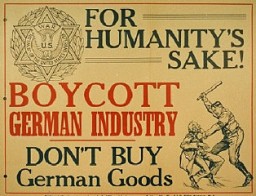
Photo
Browse an alphabetical list of photographs. These historical images portray people, places, and events before, during, and after World War II and the Holocaust.
<< Previous | Displaying results 126-150 of 227 for "Photo" | Next >>
-

-
Portrait of the family of Bohor Kalderon
PhotoPortrait of the family of Bohor Kalderon. This photograph was one of the individual and family portraits of members of the Jewish community of Bitola, Macedonia, used by Bulgarian occupation authorities to register the Jewish population prior to its deportation in March 1943.

-
Portrait of the Katz Family
PhotoGroup portrait of members of the Katz family of Munkacs. Pictured in the top row from left to right are: Chicha, Isabella, Philip, Jolon (Cipi), and Regina. In the bottom row are Helen (left) and Tereza. Munkacs, 1942–1943.
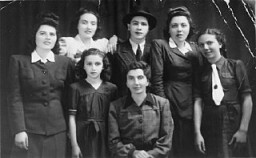
-
Portrait of the Rosenblat family in interwar Poland
PhotoPortrait of the Rosenblat family in interwar Poland. Photographed are: (back row from left to right) Elya, Jozef (father), and Itzik Rosenblat. Sitting from left to right are: Herschel, Deena (wife of Elya), Hannah (mother), and Taube Rosenblat (wife of Itzik). In 1941, a mobile killing unit killed Herschel in Slonim, Poland. Of the others, only Itzik and Deena survived deportation from the ghetto in Radom, Poland.
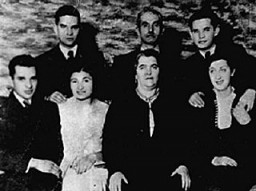
-
Portrait of the Weidenfeld family wearing Jewish badges in the Czernowitz ghetto
PhotoPortrait of the Weidenfeld family wearing Jewish badges in the Czernowitz (Cernauti) ghetto shortly before their deportation to Transnistria. Pictured from left to right are Yetty, Meshulem-Ber, Sallie, and Simche Weidenfeld. Cernauti, Romania, October 1941.
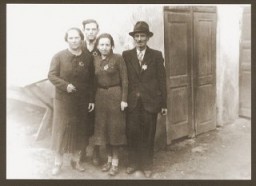
-
Portrait of three-year-old Estera Horn
PhotoPortrait of three-year-old Estera Horn wrapped in a fur coat. Chelm, Poland, ca. 1940. Estera was born in January 1937. Her father was killed soon after the Germans invaded Poland. Estera and her mother, Perla Horn, were forced into the ghetto in Chelm. At the end of 1942, during the liquidation of the ghetto, Perla and Estera escaped from the ghetto. They hid in nearby villages. In late 1943, Perla asked a family in Plawnice to take care of Estera. Perla tried to hide with a group of Jews in the nearby…
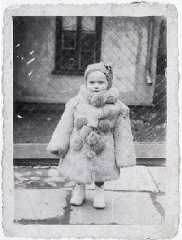
-
Portrait of Tosia Altman
PhotoPortrait of Tosia Altman (1918-1943), Jewish youth leader and member of the Jewish underground in the Warsaw ghetto.

-
Portrait of Tsewie Herschel taken while he was living in hiding
PhotoPortrait of Tsewie Herschel seated in a chair, taken while he was living in hiding. Oosterbeek, the Netherlands, 1943–1944. Tsewie never knew his parents. Born in December 1942, he was hidden with the de Jong family in April 1943. That July, his parents were deported from the Netherlands to the Sobibór killing center. The de Jongs renamed Tsewie "Henkie," raised him as a Christian, and treated him as their son. Tsewie learned about his origins from his paternal grandmother, who reclaimed him…

-
Portrait of two Romani (Gypsy) women
PhotoPortrait of two Romani (Gypsy) women. Both were deported to Auschwitz in 1941. Photograph taken in Czechoslovakia, 1937.
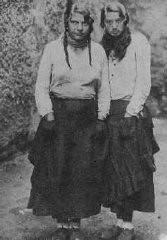
-
Portrait of two schoolchildren, Solomon Faradji and Sami Levi
PhotoPortrait of two schoolchildren: Solomon Faradji, son of Avram Faradji, and Sami Levi, son of Rafael Levi. Solomon lived at Karagoryeva 113, and Sami lived at Karagoryeva 105, in Bitola. This photograph was one of the individual and family portraits of members of the Jewish community of Bitola, Macedonia, used by Bulgarian occupation authorities to register the Jewish population prior to its deportation in March 1943.
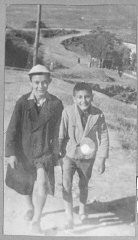
-
Portrait of Victoria and Isak Assael
PhotoPortrait of Victoria and Isak Assael, the daughter and son of Shabetai Assael. They were students and lived at Sremska 9 in Bitola. This photograph was one of the individual and family portraits of members of the Jewish community of Bitola, Macedonia, used by Bulgarian occupation authorities to register the Jewish population prior to its deportation in March 1943.
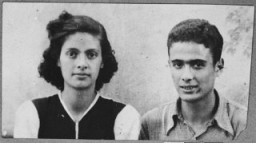
-
Portrait of Vida Kalderon
PhotoPortrait of Vida Kalderon, wife of Yakov Kalderon. She lived at Orisarska 2 in Bitola. This photograph was one of the individual and family portraits of members of the Jewish community of Bitola, Macedonia, used by Bulgarian occupation authorities to register the Jewish population prior to its deportation in March 1943.

-
Portrait of Walter Marx and his family
PhotoWalter Marx (standing at left) with father Ludwig, mother Johanna, and cousin Werner. In 1944, Walter joined partisans in Italy. He was the only one in the photograph to survive the Holocaust.
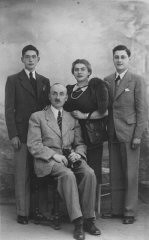
-
Portrait of writer Sigrid Undset
PhotoPortrait of writer Sigrid Undset, who won the Nobel Prize for Literature in 1928. Often with feminist themes, her novels were banned and burned in part because of her public criticism of the Nazi regime. Photo taken by Anders Beer Wilse on July 1, 1923.
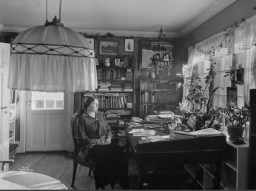
-
Portrait of Yakov Testa with his wife and three children
PhotoPortrait of Yakov Testa with wife and three children in Bitola. This photograph was one of the individual and family portraits of members of the Jewish community of Bitola, Macedonia, used by Bulgarian occupation authorities to register the Jewish population prior to its deportation in March 1943.
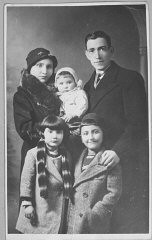
-
Portrait of Yosef Eschkenasi and his wife, Sara
PhotoPortrait of Yosef Eschkenasi and his wife, Sara. Yosef was a laborer. They lived at Zmayeva 10 in Bitola. This photograph was one of the individual and family portraits of members of the Jewish community of Bitola, Macedonia, used by Bulgarian occupation authorities to register the Jewish population prior to its deportation in March 1943.

-
Portrait of Żegota co-founder Władysław Bartoszewski
PhotoPortrait of Władysław Bartoszewski, Poland, unknown date. Władysław Bartoszewski (1922–2015) was a co-founder and member of the Council for Aid to Jews, codenamed “Żegota.” Żegota was a clandestine rescue organization of Poles and Jews in German-occupied Poland. Supported by the Polish government-in-exile, Żegota coordinated efforts to save Jews from Nazi persecution and murder. It operated from 1942 to 1945. After World War II broke out in September 1939, Władysław worked as a janitor…
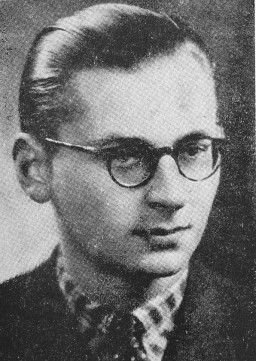
-
Portrait of Żegota member Andrzej Klimowicz
PhotoWartime portrait of Andrzej Klimowicz, Poland. Andrzej Klimowicz (1918–1996) aided and rescued Jews in Warsaw throughout the duration of the German occupation of Poland. He eventually became a member of the Council for Aid to Jews (codenamed “Żegota”), a clandestine organization that coordinated efforts to save Jews from Nazi persecution and murder. Under the auspices of Żegota, Andrzej played a role in providing Jews in Warsaw with forged identity papers and hiding places outside the walls of the…
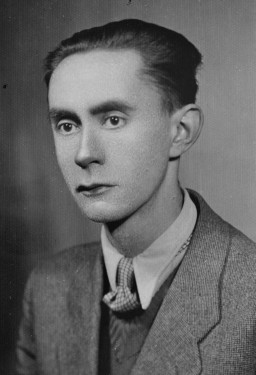
-
Portrait of Żegota member Irena Sendler
PhotoPortrait of Irena Sendler in Warsaw, Poland, circa 1939. Irena Sendler (1910–2008) was a member of the Council for Aid to Jews, codenamed “Żegota.” Żegota was a clandestine rescue organization of Poles and Jews in German-occupied Poland. Supported by the Polish government-in-exile, Żegota coordinated efforts to save Jews from Nazi persecution and murder. It operated from 1942 to 1945. Irena Sendler (Sendlerowa) was working as a social worker in Warsaw when World War II broke out in 1939. After…
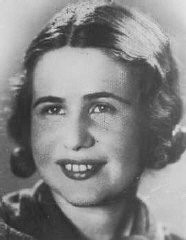
-
Portraits of Martha and Waitstill Sharp
PhotoPortraits of Martha and Waitstill Sharp from an unknown newspaper. Published before they left for Europe on a relief mission with the Unitarian Service Committee.
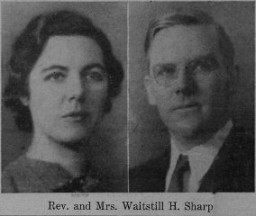
-
Portraits of Zionist leaders hang in a classroom
PhotoLyrics to the Jewish national anthem and portraits of Zionist leaders hang in a classroom in a displaced persons camp. Feldafing, Germany, after April 1945.

-
Postcard of Evian-les-Bains
PhotoPeriod postcard of Evian-les-Bains, the site of the 1938 International Conference on Refugees.
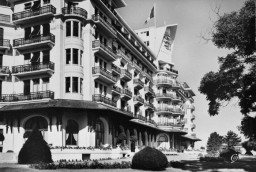
-
Postcard of the SS St. Louis
PhotoA postcard of the SS St. Louis. May 1939. The plight of German-Jewish refugees, persecuted at home and unwanted abroad, is illustrated by the May 13, 1939, voyage of the SS St. Louis.

-
Poster advertising the antisemitic propaganda film "Der ewige Jude"
PhotoA poster advertising the antisemitic propaganda film "Der ewige Jude" (The Eternal Jew) hangs on the side of a Dutch building. Amsterdam, The Netherlands, 1942.
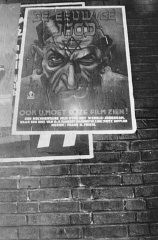
-
Poster calling for a boycott of German goods
PhotoPoster calling for a boycott of German goods. Issued by the Jewish War Veterans of the United States. New York, United States, between 1937 and 1939.
